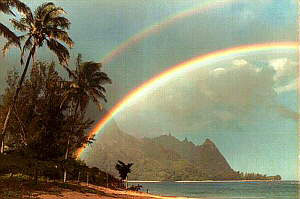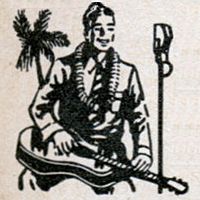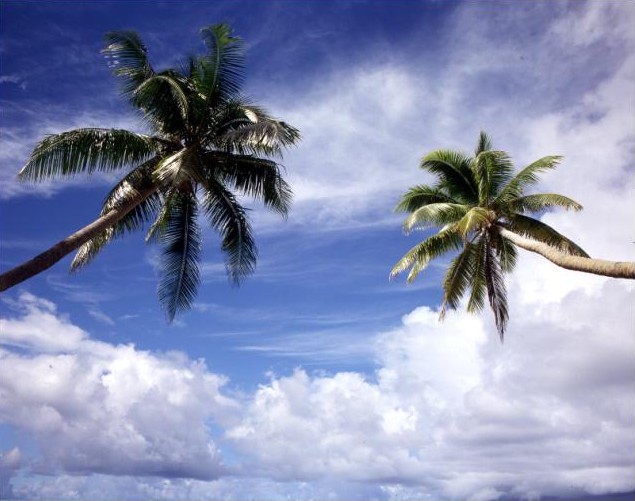 The
E9th pedal steel is perfect for playing Hawaiian music...
The
E9th pedal steel is perfect for playing Hawaiian music...
“Steel guitar is a Hawaiian instrument by birth and what I consider to be the
signature sound of Hawaiian music. Having undergone many changes, both
physically and musically, in the hundred-plus years of its existence, it
is, I will say without hesitation, one of the most difficult instruments
to master.” —Jerry Byrd, “It Was A Trip On
Wings Of Music,” by Jerry Byrd (1920-2005); © 2003, p. 110.
There are a few
things to consider about playing Hawaiian music on the pedal steel. First, here is a video of me
trying to play “Beyond The
Reef” on the E9th pedal
steel so you can see that it can be done. You'll see that I'm using bar
slants. I am playing it first in C6th as if it were a lap steel (by lowering
the E's to Eb), but then I
finish by using the colorful E9th pedal steel...
Beyond the Reef 01.
The pedal steel brings a vibrant eyebrow-raising sound to standard non-pedal
songs. Basically, you're mixing Country and Hawaiian. Of course, this is not
traditional Hawaiian music. To sound authentic, you must not let your
listener know that you are using pedals. This is accomplished simply by
pressing the pedals or knees before picking the strings.
Note that at 2:07 to 2:11 in the preceding video for “Beyond the Reef,” I
use “palm harmonics” to play that pretty piece. I start at fret 13 and then
move up to fret 15, pressing A and B pedals. In this harmonic technique, I
place the palm of my right hand across strings 5,6 and 8 and chime all three
notes together. Most steel guitarists only think of chiming one note at a
time, but you can chime as many notes as your finger and palm can cover. I
often chime strings 3 and 4 together at the end of a song using my 2nd to
pinky finger. I've watched Lloyd actually lay his middle finger (it might be
his pinky) on strings 3 and 4 to silence them first, and then he chimes them
by individually picking them simultaneously with his thumb and forefinger.
Cool!
Also, native Hawaiians don't recognize most of the Hawaiian steel guitar
favorites that we cherish. Native Hawaiian music features only percussion
and chants. It was Hollywood that introduced many of these new songs, such
as “Beyond The Reef” and “Lovely Hula Hands” (sang by Elvis, Bing Crosby,
Marty Robbins and others). Those are the songs that steel guitarists love to
perform.
So there are two things to consider here: one is that you can just lower
your 4th and 8th strings to Eb and play the E9th pedal steel neck as if it
were a C6th non-pedal steel (you just need to avoid the 9th string, which
will produce a sour tone). From strings 10 to 4 you have the C6th tuning (as
long as the E's are lowered on strings 4 and 8). Pretty cool huh? And if you
depress pedals A and B together, and lower string 8, you have the B11th
tuning (you can't lower 4 though, so when I avoid string 4 when 8 is
lowered, and vise versa). I'm telling you this so you'll understand that you
CAN perform Hawaiian music on your E9th neck.
Perhaps no one better
demonstrates what I am saying than my ole friend Leonard T. Zinn. I first
heard Leonard back in 1994 at an Indy Gospel Show. Thankfully, I recorded it
all and recently burned Leonard's recordings to WAV and MP3 files. Here are
the MP3's of ten songs (192kbps). Leonard for as long as I've known him has
played a S-10 MSA. In these songs you'll hear some of
Leonard's beautiful Hawaiian style, which you can learn from. In particular,
Leonard makes superb usage of chord progressions, which few steel guitarists
ever learn. Well, here's your chance (I cherish these recordings and I'm
sure you will too)...
-
Amazing Grace
-
He Touched Me
-
It Is No Secret
-
Jesus Keeps me Singing
-
When They Ring Those Golden Bell
-
Nearer My God To Thee
-
Peace In The Valley
-
Something Beautiful
-
Just A
Closer Walk
-
Where Could I Go But To
The Lord
Here's Leonard playing a
Hawaiian favorite...
Beyond The Reef -
Leonard T. Zinn
Keep in mind that Hawaiian music is a STYLE and not a
tuning. With that in mind, I recommend trying to learn the techniques
particular to Hawaiian music and then apply them to the E9th. The best way
to do this is to listen to lots of Hawaiian music. Leonard Zinn has some
albums available, great stuff, where you can hear him performing Hawaiian on
the E9th (but you won't hear the pedals). The trick is to press the pedals
BEFORE you pick the strings, so you don't hear that famous "twang" in
Country music.
Again, keep in mind that you have a complete C6th 6-string right there on
your E9th neck. By using the E knee to lower strings 4 and 8 a half tone,
you have the C6th tuning. On fret one, with the E's lowered you have from
the 4th string to the 10th (treble to bass)...
E - C - A - G - E - D# - C
String 9 is the only undesired note. If you carefully
avoid the 9th string, you have a complete 6 string C6th tuning. Ninety
percent of
everything played on the C6th is played on the 1st few strings anyway. With
the E's lowered, strings 4 through 8 on your E9th pedal steel neck are the
same as strings 1 through 5 on a C6th lap steel. So I generally leave string
10 alone. That way I don't have to worry about the sour note if I hit string
9. It works fine for playing Hawaiian.
Having said that, if you get
Jerry Byrd's tabs and instruction course
(highly recommended) for C6th from Scotty's Music, then you can play most of
it on your E9th pedal steel with the E's lowered. In fact, Jerry recorded
many of his Hawaiian songs on a non-pedal Sho-Bud guitar that Shot Jackson
custom-built for him in the 1970's. Jerry hated the guitar at first, which
he devotes a chapter to in his autobiography (It
Was A Trip On Wings Of Music).
In fact, that's the basic premise behind the Universal Tuning, that is, a
12-string hybrid pedal steel guitar that gives you E9th and C6th all in one.
I started out learning on a D-10, so I have never gone to Universal, but it
is intriguing and tempting.
You can play anything on E9th pedal steel that you can on a C6th lap steel.
Just lower the E's. Your C6th tuning is found on fret one of the E9th pedal
steel, so actually, with the strings open and the E's lowered you have a
B6th on your pedal steel.
Leonard Zinn has recorded some wonderful Hawaiian albums using an S-10 E9th
pedal steel. I highly recommend listening to his recordings because he
definitely has an authentic Hawaiian style. Here is Leonard playing "Song Of
The Islands" on C6th non-pedal steel, where you can hear his great STYLE...
Song Of The Islands - Leonard T. Zinn
Learning the Hawaiian style in my opinion is the key to playing Hawaiian in
any tuning.
Here are some tabs on how to play 9th chords on the C6th lap steel. These
are C9th chords. You can play these exact same chords on your E9th by
lowering the E notes...
E___10____________________________________________________________
C___10___14___2___________________________________________________
A________13___1___________________________________________________
G___9_____________________________________________________________
E________12___0___________________________________________________
C#________________________________________________________________
|
The first chord above is a C9th chord and is a somewhat popular tuning for
Hawaiian music. Jerry Byrd plays "Moon Of Manakoora" in the D9th tuning
(tabs available from Scotty's Music). All you need to do to change your C6th
to D9th on a lap steel is lower string 4 from G to F#. On the E9th pedal
steel you can do a bar slant to get a D9th chord.
This is why I highly recommend learning to play the C6th lap steel for all
pedal steel players. It can all be played right on your E9th pedal steel.
Most E9th pedal steel players don't realize that they have everything right
in front of them to play authentic Hawaiian music.
Plus you have the benefit of giving the song a country flavor as well. I
sometimes like to play the first part of a song using the C6th on my E9th
pedal steel (Hawaiian style), and then play it country style using the
pedals for the last part. It makes the song more interesting to the audience
of listeners. They get to hear Hawaiian and then country.
In my opinion, C6th is much better for Hawaiian music, which is great for
E9th pedal steel because you have the C6th and a whole lot more available.
You also have the B11th tuning on the E9th pedal steel, which is very
popular for Hawaiian songs (such as Sand, How D' Ya Do, Hana, Mapuana, et
cetera). Open fret, by pressing the A and B pedals, you have the B11th
tuning on strings 4 through 7. If you lower string 8 when needed, that will
give you the 5th string of the B11th tuning. The B11th tuning is (treble to
bass)...
E - C# - A - F# - D# - C#
The beautiful thing about having the E9th pedal steel guitar is that you
have the C6th, the B11th, the D9th, the E9th and other tunings at your
disposal. Most players don't even realize that they've been playing B11th,
C6th, A7th, D9th and other tunings for years.
Play The E9th Pedal Steel Without
Using Any Knees Or Pedals,
Just Like You Would A Lap Steel...
Jerry Byrd's “ADMIRABLE
BYRD” album is all E9th and can be played directly on the E9th pedal steel,
note for note. Here's Jerry's E9th tuning (from high to low: E, B, G#, F#,
E, D, B, G#). Jerry usually uses a G# on string 8, but on some songs, like
“It Is No Secret,” he switches strings 7 and 8 (i.e., G# on string 7, and B
on string 8). Sometimes Jerry also uses an E note on string 8, but
everything he performs on the album “Admirable Byrd” uses the tuning
specified above, with a G# on string 8.
If you get the tabs for "SAND" in B11th, you can play it on your E9th pedal
steel, you just need to remember that the top E note (string four) needs to
be E, and your bottom E (string eight) needs to be Eb. So you can't really
strum the B11th tuning, but you can play a song like "SAND" which doesn't
require a full strum. Of course, if you don't lower your 4th string like
Jimmy Day and Lloyd Green, then you have a perfect B11th tuning with pedals
A and B down. You also have the C# note on string 10 to complete the B11th
(but again, you must avoid that sour note on the 9th string).
This all relates to playing Hawaiian music on the E9th. There's really no
such thing as playing Hawaiian music in the E9th tuning on a pedal steel
(unless you don't touch the pedals or the knees). By using the pedals and
knees you are using the C6th, B11th, A7th and other tunings to obtain your
sounds. So my point is why not learn those particular tunings and play it on
your steel? In particular, I'd stick to C6th to avoid being overwhelmed at
first. C6th is the way to go.
Jerry Byrd often said that the C6th is the most versatile of all the
tunings. He may have changed his opinion in latter years with his diatonic
tuning (which is nothing less than genius, but that's a different story and
strictly non-pedal steel guitar). The tuning is (treble to bass)...
E - C - B - A - G - F - E
(Jerry's experimental Diatonic tuning)
Danny Boy is awesome in Jerry's diatonic tuning. But going back to the C6th,
Jerry Byrd used the C6th throughout his career, as did others.
Don't be afraid to learn the C6th, because you've been playing it on C6th
all along, every time you lower your E's. The thing that you need to learn
is how to play lap steel tabs on it. Here is an example, my tabs in C6th for
“Beyond the Reef”...
Beyond the Reef Tabs using C#
Beyond the Reef Tabs using Bb
I'm grateful to God that I've been blessed to play steel guitar since 1992.
What a beautiful, majestic and challenging instrument! I've never heard
anyone teach this, but the best way to learn the C6th pedal steel is to
first learn lap steel. I had a hard time comprehending the C6th pedal steel
at first.
Whereas you can play an entire song on one fret on the E9th pedal steel
(having the entire chromatic scale available); you cannot do that on C6th
because you need to move the bar to obtain a chromatic scale (12 notes of an
octave). C6th is a different mindset. Some of the older players who began on
C6th lap steel had a hard time learning the E9th pedal steel years later,
because it is a different mindset. They're both beautiful tunings.
Like many players, I relied on tablature and memorized tabs to play a C6th
song on pedal steel. You can move beyond that if you'll take up C6th lap
steel. It will open the eyes of your understanding. Plus, you'll have a new
skill on lap steel, which you can carry under your arm and is very
lightweight. Lap steel is awesome and you can play so much. Most beginners
to lap steel are not aware that Jerry Byrd wrote an instruction course and
that many tabs are available. Jerry's instruction course and tabs are
awesome.
I didn't take up lap steel until I started having neck problems (peripheral
neuropathy) in 2004. When I learned the basic C6th and the need for bar
slants to obtain the different chords, it became clear as day why the C6th
pedal steel was designed the way it is (but that's a different subject).
I recommend buying some of Jerry Byrd's Hawaiian albums and pick some songs
that you would like to learn. Then request a list of Jerry Byrd tabs from
Scotty's music and see if C6th tabs are available for the song you like.
Jerry tabbed out hundreds of individual songs. Then learn to play it on your
E9th pedal steel (with the E's lowered to give you C6th).
Keep in mind that authentic Hawaiian steel guitar does not use pedals and so
it's important to be careful to avoid the "twang" distinctive to country
music. You simply press the pedals first to obtain your desired chord, and
then pick or rake the strings.
Technique is everything in Hawaiian music. For example: sliding up an octave
is a distinctive Hawaiian sound. With your E's lowered, pick or rake across
strings 8 through 4 at fret 3, letting the notes ring, and then slowly slide
up an octave to fret 15. This is the most popular sound in Hawaiian music.
Here's another version of "Beyond The reef" on E9th pedal steel. You can
hear the classic Hawaiian octave slide which I am referring to at the end...
Beyond The Reef 03
Another great Hawaiian technique is to mute the strings at the bridge. You
don't want your hand on the bridge, but just before the bridge. Here is an
example of muting sounds like at 2:00 in the video. This technique can be
used on pedal steel too. I am playing in the A6th tuning here, which is the
same as C6th with a high G (just 3 half tones lower)...
Sweetnin'
I have enjoyed learning to play lap steel so much, and it has greatly helped
me to understand the pedal steel. I couldn't figure out for years how Lloyd
Green (I love Lloyd and Jerry Byrd, they are my musical heroes) obtained a G
note on the 6th string by doing a forward bar slant. I tried and tried and
it never sounded right. I just couldn't figure it out and it was so
frustrating.
When I bought Jerry Byrd's steel guitar instruction course from Scotty,
Jerry showed the way to do a forward bar slant to play a diminished and
augmented chord on the C6th. There's a drawing in the book showing the bar
tip positioned exactly BETWEEN the two strings. That blew me away because I
couldn't understand that technique for so long. I couldn't grasp that
concept until I actually saw it. I had been slanting my bar across string 4
only, so string 5 was flat and sounded terrible. You have to place the bar
directly in the middle of the strings, so that the tip of the bar rests
between the strings. You can see and hear me play this chord at 3 seconds
into the following video, doing a forward bar slant. I love this chord and
use it quite a bit now in my style...
Example of Dominant 7th Chord using forward bar slant
E9th pedal steel is perfect for Hawaiian playing, it's just a matter of
learning some basic Hawaiian techniques. There are many different styles
that can be played and that's what I recommend, that is, focusing on the
techniques of the Hawaiian style.
Vibrato is another important technique and a distinctive characteristic of
Hawaiian music. Here I play "Near The Cross" in the Hawaiian style, using
simple single notes with a lot of vibrato. You could play this easily on the
E9th pedal steel guitar...
Near The Cross
Bud Tutmarc's style was characterized by mostly single note playing on the
C#minor7th lap steel tuning.
Lots of reverb is a distinctive characteristic of certain Hawaiian songs,
such as "Moon of Manakoora" and "Bali Hai," producing a dreamy effect to the
song. In other songs, like "Lovely Hula Hands," too much reverb would ruin
the song.
Harmonics are an important aspect of playing Hawaiian music in any tuning.
Some songs like, "Kewalo Chimes," are performed completely with natural
harmonics. "Natural" meaning that you chime the open strings at frets
5,7,12,19 or 24. It is easier to chime frets 5 and 7 by picking slightly
closer to the bridge.
The volume pedal is also important, VERY important to learn. Jerry Byrd
mastered the technique of picking a string with the volume pedal backed off,
and then he would slide up into a note while raising the volume. Here's a
perfect example of this technique from the song "Sophisticated Hula." This
may seem difficult to do, but it simply requires getting the "feel" for it.
A lot of techniques are more felt than anything. All jerry is doing is
picking the note before pressing down the volume pedal, and he slides up
into the note at the same time. This is a Hawaiian technique that can be
used on the E9th pedal steel (as well as any steel guitar)...
Example of using volume pedal for Hawaiian technique
Hawaiian guitar is a unique style that once learned is like riding a
bicycle, that is, you'll never forget how to do it. The steel guitar is
profoundly simple, yet takes a lifetime to master. I've just scratched the
surface and have so much more to learn. I love the challenge. After playing
steel guitar for decades, I'm more of a student today than ever before.
I don't claim to be an expert, just an amateur that's still hungry to learn
and share what I learn with others. God bless.

 The
E9th pedal steel is perfect for playing Hawaiian music...
The
E9th pedal steel is perfect for playing Hawaiian music...



